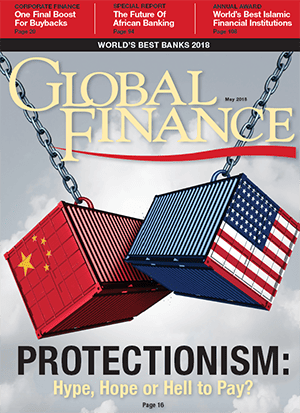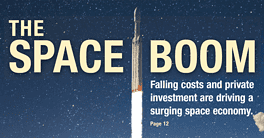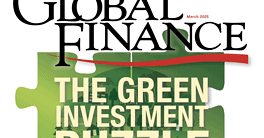Global Finance magazine editor Andrea Fiano's monthly letterfocuses on how corporate leaders are reacting and adapting to the prospect of a U.S.-China trade war.
MAY 2018 | VOL. 32 NO. 5

Dear Reader,
We do not know whether duelling tariffs—those announced first by the US and those announced subsequently by China—will actually take effect in the coming months, and even less what their effect might be.
The CEO of a major global oil company recently told us that he views the trade threats and harsh rhetoric between the two leaders as a kind of “foreplay” to a serious and long overdue discussion of intellectual property. A fund manager sees the dramatic public announcements as tough bargaining tactics, commenting that “politicians negotiate through the media these days.” Jamie Thomson of Oxford Economics notes that “there are no winners in trade wars,” yet at the same time, “the fall-out from President Trump’s protectionist trade measures is likely to be more limited than many assume.”
Time will tell. One aspect of this controversy highlights the deep interconnectedness that globalization has wrought, particularly in the global supply chain. Simon Baptist, chief economist of the Economist Intelligence Unit, notes that 40% of the apparent value of China’s manufacturing exports is actually generated in other countries (mostly Japan, South Korea and, notably, the US). “So for every dollar of tariffs on Chinese manufacturing,” he says, “around 40% ultimately affects other countries earlier in the supply chain.” China’s proposed retaliatory tariffs on US agricultural products, on the other hand, offer narrower consequences: “only 10% affects other countries,” according to Baptist. So the uncertainty on tariffs is not just about implementation or impacts, but about potential side effects, too. The long-term and short-term uncertainty has lately brought volatility back to financial markets worldwide, despite continued economic growth.
Our cover story analyzing the trade tensions and possible scenarios does not reach an unequivocal conclusion. We examine different possible outcomes yet feel no confidence in forecasting. Not to mention that unintended consequences are possible in all things, but especially in global trade matters.

Andrea Fiano | Editor
afiano@gfmag.com

